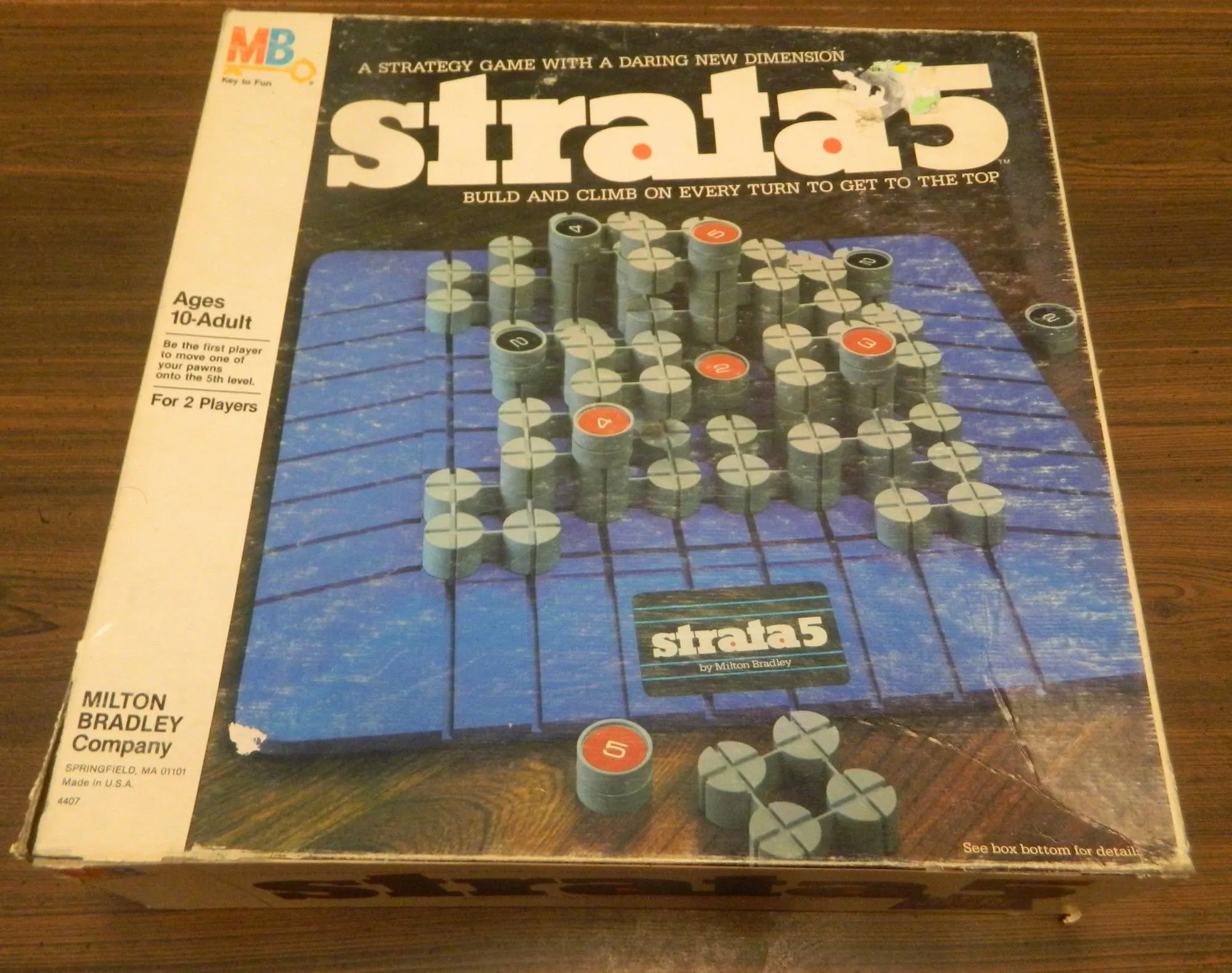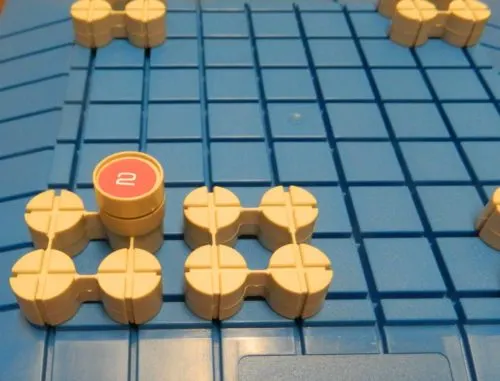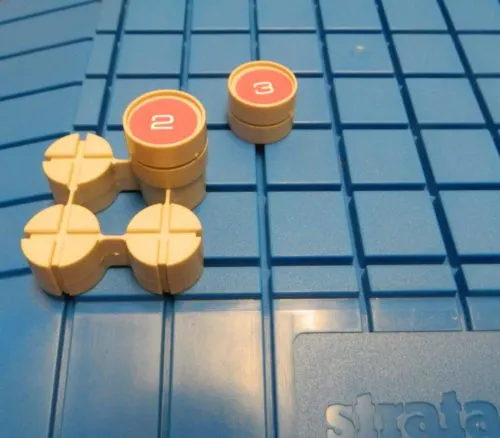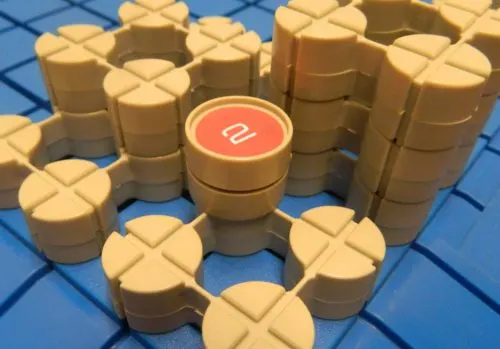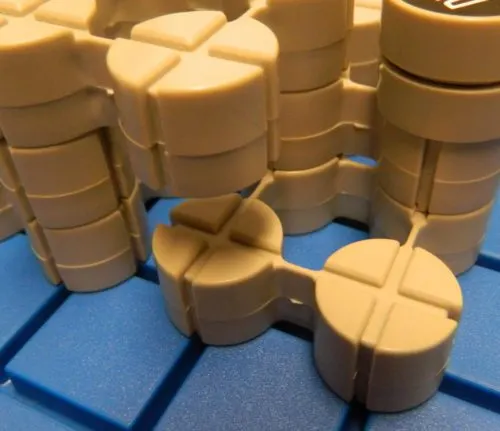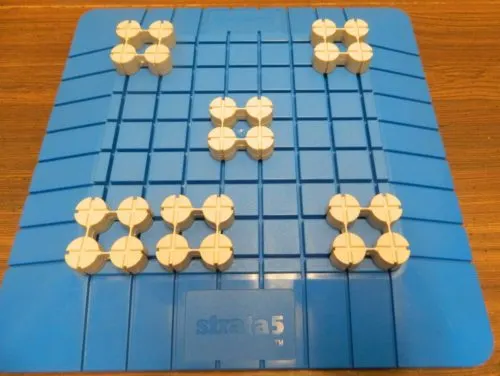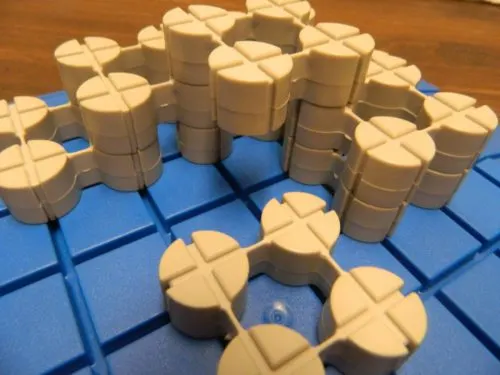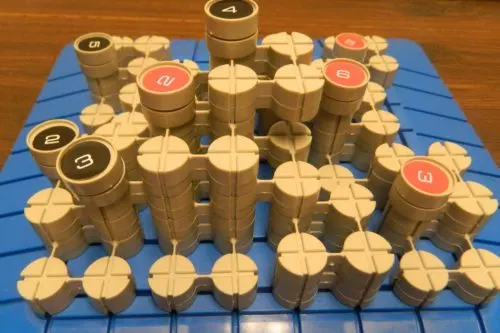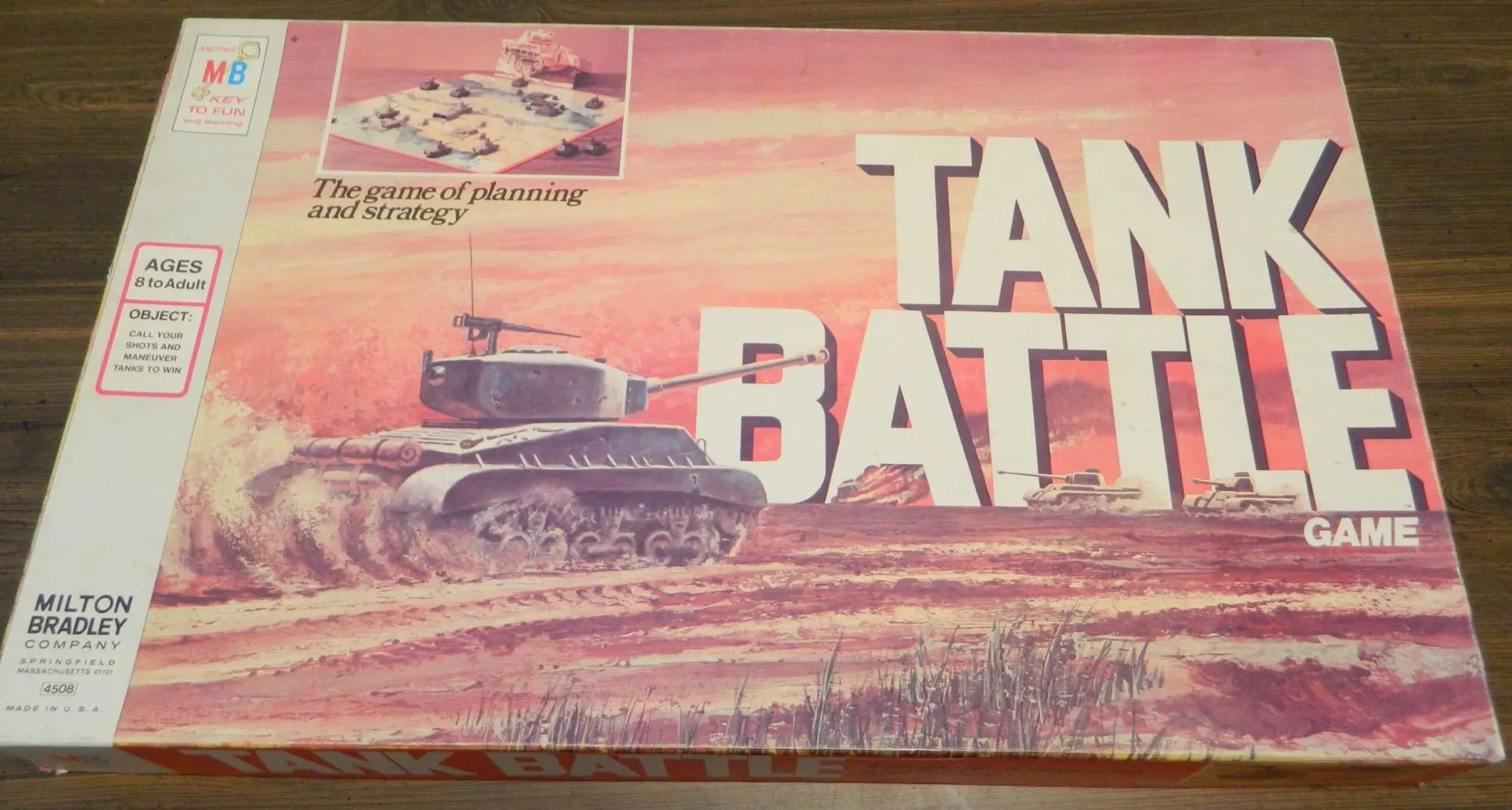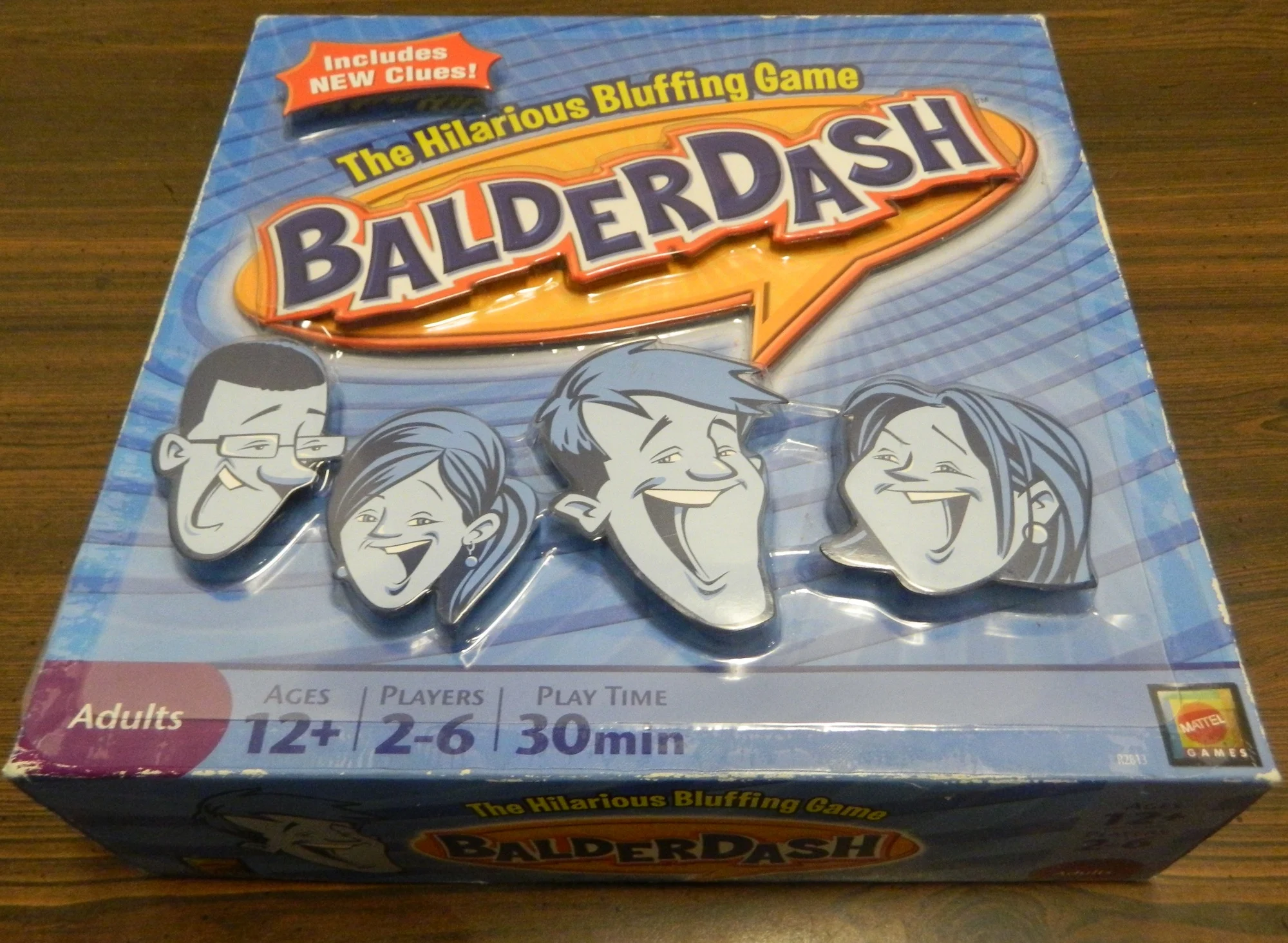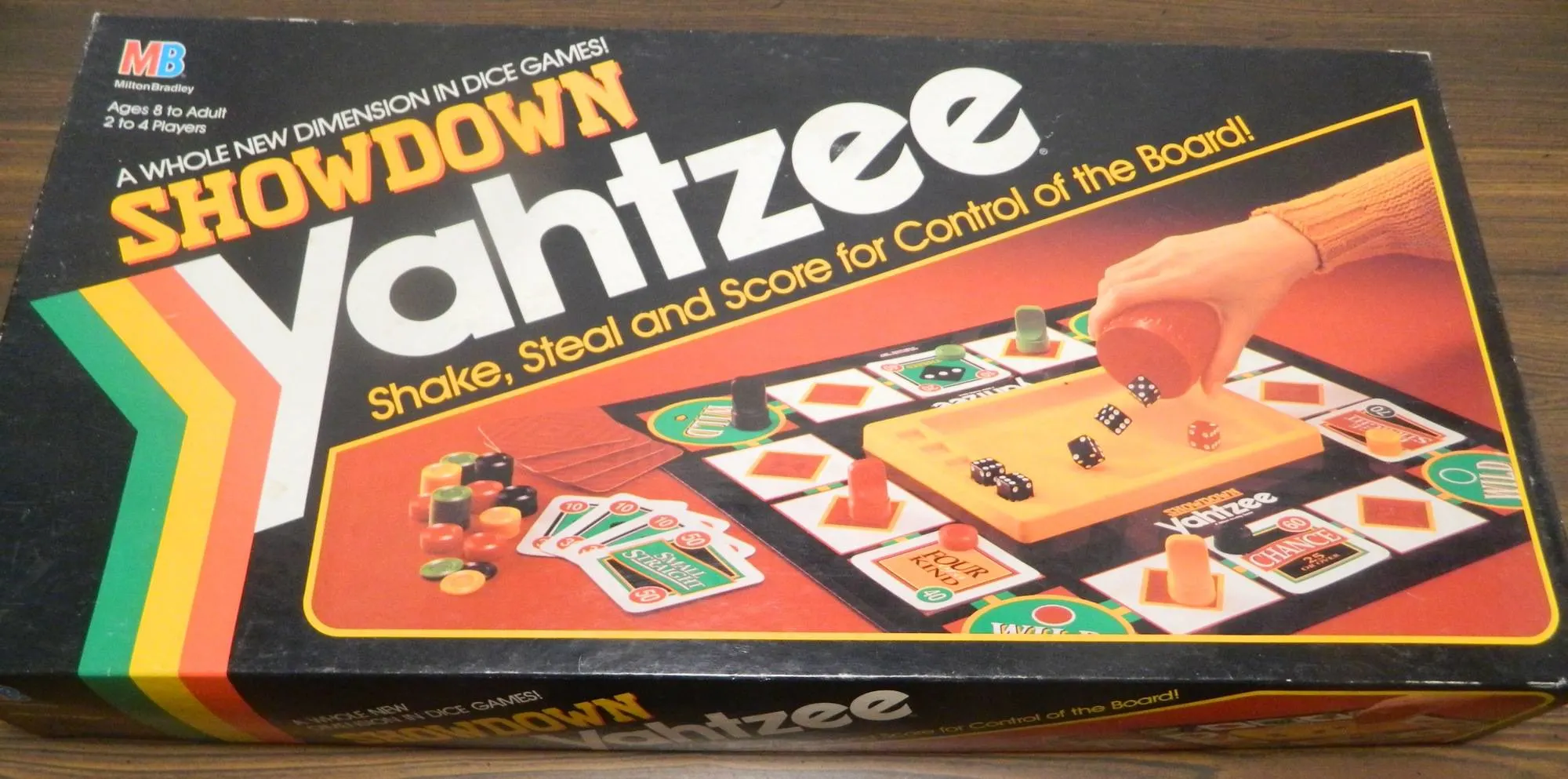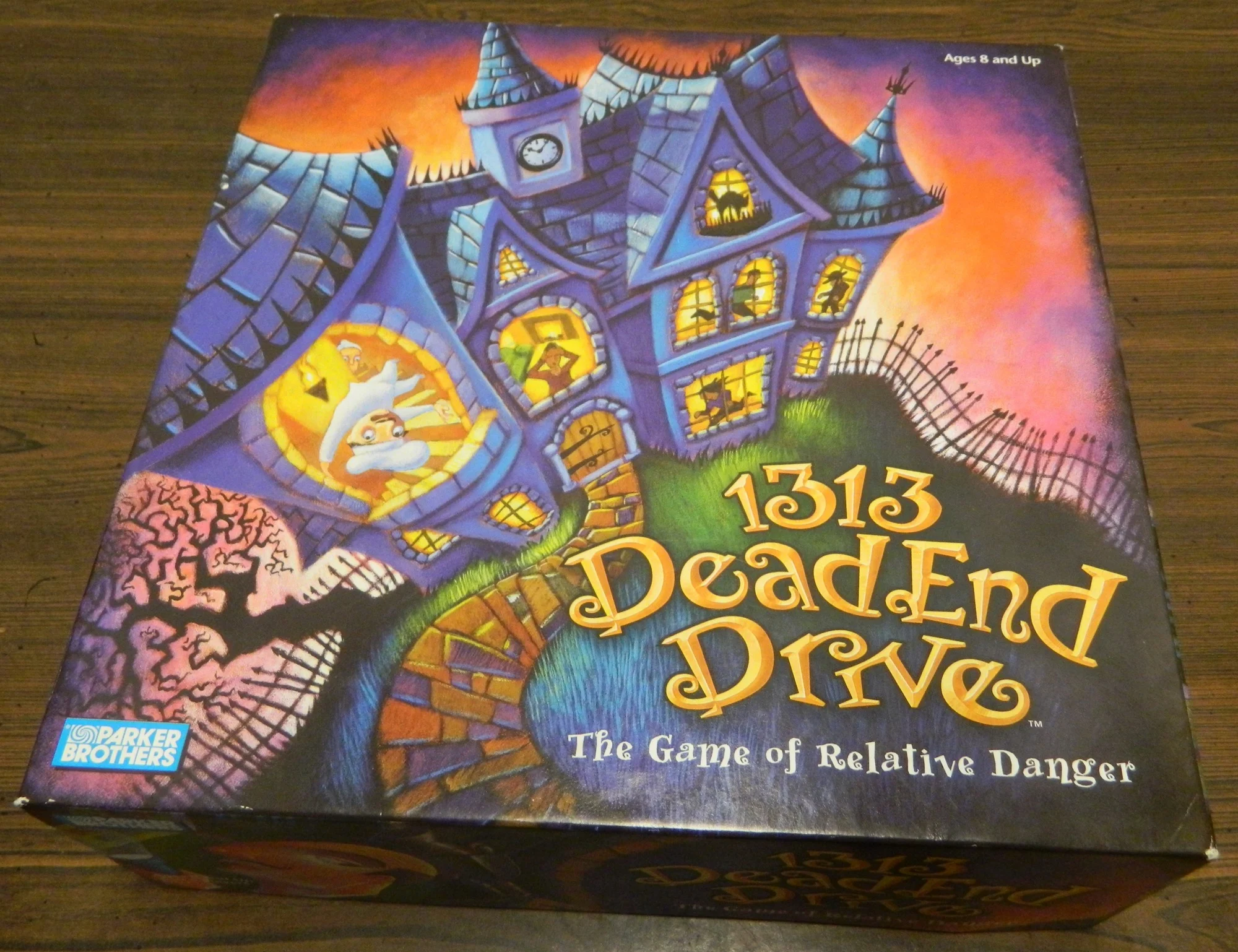The abstract strategy genre is a genre that I have always had some mixed feelings about. For the most part abstract strategy games are focused exclusively on gameplay and either don’t have a theme or when they do it is very light. The reason that I have mixed feelings about the abstract strategy genre is that the games rely entirely on the strategy. If the strategy is compelling, the game is fun. If not the game can become dull quickly. When I first saw Strata 5 I was interested because the concept of a abstract game based around building a 3D sculpture was intriguing. Strata 5 has all the makings of a good abstract strategy game that ultimately fails due to a few bad decision choices.
How to Play Strata 5
Setup
- Place the game board between the two players.
- Place one building block in each of the four corners. The rest of the building blocks are placed to the side of the board.
- Each player takes the following pawns: two 2’s, one 3, one 4, one 5, and one 6.
- The players choose which player will be red and which will be black. They flip their pawns to the corresponding color.
- Choose which player will start the game.
Playing the Game
On a player’s turn they will take two actions:
- Move up to two of your pawns.
- Place a building block.
Moving Your Pawns
To begin each player’s turn they will have the opportunity to move two of their pawns. Each pawn enters the game board on one of the two starting blocks (the blocks in the corners) on your side of the board. Placing the pawn counts as one of the spaces it will move that turn. When a pawn is moved, it must be moved as many spaces as the number on the pawn. For example a three pawn must be moved three spaces. While moving a pawn the following rules must be followed:
- A pawn must be moved horizontally or vertically. It can never be moved diagonally.
- A pawn cannot move onto the blue surface of the game board.
- When moving between levels, a pawn can never jump up or down more than one level for each space moved.
- A pawn cannot move through a space occupied by another pawn. Your pawn also can’t land on a space occupied by another of your own pawns. A pawn can land on a space occupied by an opponent’s pawn though (see capturing below).
- You can never move a pawn through the same space twice on the same turn.
- A pawn can never land on a space that is directly under a building block that is hanging over an edge.
If a player is unable to use one or both of their moves on their turn, they must forfeit those movements.
If a player is able to land on top of one of their opponent’s pawns by exact count, they will capture the pawn. The capturing player removes the captured pawn from the game board. The player flips the pawn over to their color. The pawn now belongs to the capturing player.
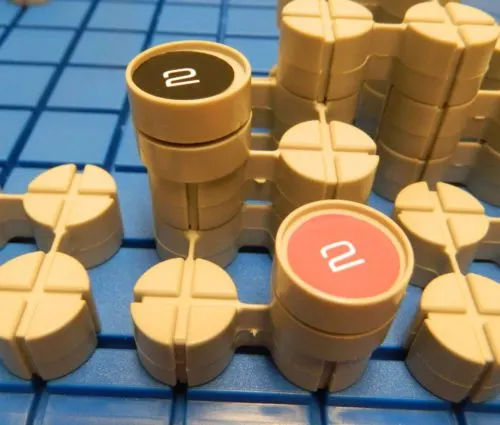
In this situation one of the players will be able to capture the other player’s pawn by landing on the same space. The black pawn could move right and down or the red pawn could move left and up.
Placing A Building Block
After moving their pawns the current player will add a building block to the game board. When placing a building block, the following rules must be followed:
- When placing a block on the game board’s surface, at least one space of the block must touch another block horizontally or vertically on the game board.
- A building block cannot be placed directly on top of another building block. At least three of the spaces of the building block must be on top of two or more building blocks.
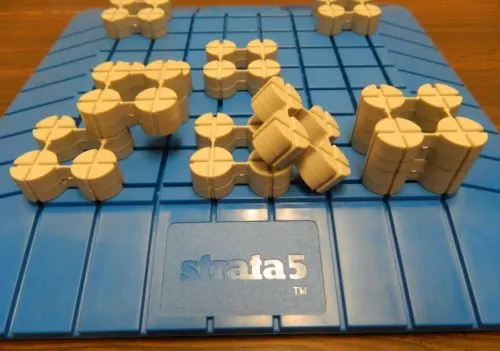
The block on the second level on the left was properly placed since three of the spaces are on top of two different blocks. The block in the center was improperly placed as only two of the spaces were on another block. The block on the right was also placed improperly because it was placed directly on top of another block.
- You can never place a building block above the fifth level.
- Once a building block is placed, it cannot be moved.
- A building block cannot be placed on a space where there is a block hanging over the space.
After placing your building block, play passes to the other player.
When placing a building block, a player can mess with the other player’s pawns. A player can use one of their own or one of their opponent’s pawns as a support for a building block as long as all of the other building rules are followed. When a building block is placed on top of a pawn, that pawn becomes part of the game board and can no longer be moved.
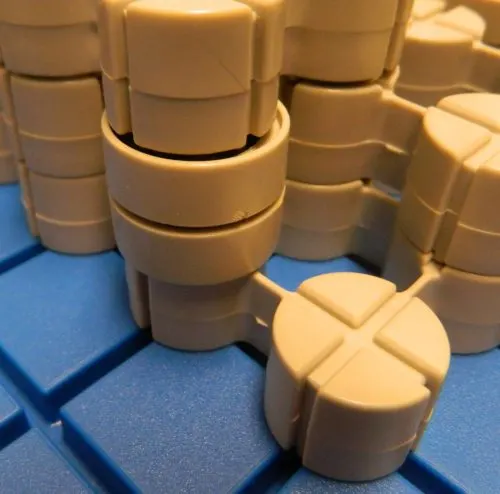
A player has placed a block directly on this pawn. This pawn is now part of the structure and can no longer be moved for the rest of the game.
A pawn can also not be moved if a player creates an overhang above the pawn. Finally blocks can be placed in a way where it is no longer possible for a pawn to move.
End of Game
Strata 5 can end in a couple different ways.
If a player can land one of their pawns on top of a fifth level building block by exact count, the player automatically wins the game.
A player can also win the game if they either capture or block all of the other player’s pawns so they can no longer move.
Once all of the blocks have been placed, players no longer place blocks. If there is a block on the fifth level that can be reached by pawns, the game continues until someone reaches the top. If there are no blocks on the fifth level or the block cannot be reached, the game ends in a draw.
My Thoughts on Strata 5
At first glance Strata 5 really interested me. For an abstract game, it had some really interesting ideas. Basically the goal of the game is to get one of your pieces onto a building block that is five levels above the base of the game board. You begin your turn by moving two of your pieces. Each piece is moved the number of spaces indicated on the piece. After moving your pieces, you add a building block to the game board. Players can use these two actions to capture each other’s pawns, place blocks on top of pawns, and even build walls around their opponent. Players need to figure out how to use the mechanics to find their own way to the fifth level while preventing their opponent from doing the same.
At its core I think Strata 5 had a lot of good ideas. It has a strong foundation which is needed for a good abstract strategy game. Instead of just working on a 2D plane, players have to think about how they are going to move and build in 3D. To elaborate, let’s quickly talk about the different mechanics in Strata 5.
First there is the movement mechanic. At first glance the movement mechanic seems pretty straightforward but it has some depth to it. Basically each piece must be moved the number of spaces indicated on the piece’s sticker. Which pieces you decide to move each turn gives you different movement options. Pieces that move less spaces have more flexibility but can’t reach a destination as quickly. High numbers can move quickly to a new spot on the board but their options are much more limited. While figuring out which pieces to move and where to move them, players have to be aware of the other player’s pieces so they aren’t able to capture your pieces.
Once you have moved your pieces, you get the opportunity to place a building block. The building rules for the most part are pretty straightforward. Your first thought would probably be to just make a really tall tower but there are two rules preventing you from doing that. First you are not allowed to place a building block directly on top of another block. In addition, pawns can only move up/down one level for each space they move. Thus in order to get a pawn up to the fifth level, you have to build a staircase out of blocks. Building a staircase five levels high doesn’t sound that difficult until you factor in the other building rules.
I was really interested in the building aspect of the game for a couple reasons. The superficial reason was that the 3D structure that is created actually looks pretty cool. There is also a decent amount of strategy behind building the structure. As you can’t place a block directly on top of another block, you have to plan ahead in order to create a structure five levels high. Third, it felt like there would be some back and forth as you tried to build your own structure while the other player messed with you.
The thing that I found most interesting about the building mechanic was the fact that you can use pawns as supports for building blocks. This was interesting because you can either trap one of the other player’s pieces under a block that you are placing or you could sacrifice one of your own pieces in order to build quicker. Sacrificing one of your own pieces is really interesting as it allows you to build upwards quite a bit quicker. You will lose some flexibility in the movement phase as you are losing pawns. You are also increasing the odds of the other player taking the rest of your pawns and winning the game. Choosing the right time to sacrifice one of your pawns can win you the game though.
At first glance it looked like Strata 5 would successfully combine these mechanics together in order to give players quite a few different strategic options. With the flexibility of movement and how you decide to build a tower, it seemed like the game gave players a lot of strategic choices. This is supported by the fact that there are actually a couple different ways of winning the game. The most obvious way to win is to get one of your pawns to the fifth level. For more aggressive players though you could try to capture all of the other player’s pawns. Finally you could place blocks in order to trap another player’s pawns so they can’t be moved. As I always like games that give you multiple ways to win, I thought Strata 5 was going to give players a lot of strategic decisions.
On top of all of this, Strata 5 is not all that complicated. The basic rules are quite straightforward. There are a few nit picky rules with regards to movement and placing building blocks. These rules can be learned pretty quickly though as they are mostly common sense. I would say that it would take most people just a couple minutes to grasp the game. It may take a few games to fully understand the strategy but players shouldn’t have trouble with the gameplay itself. Strata 5 has an age recommendation of 10+ and I am guessing that is mostly because younger children won’t really understand the strategy behind the game. They shouldn’t have any troubles with the gameplay but I could see them having some issues with the strategy side of the game.
If I stopped the review at this point I would actually say that Strata 5 is a pretty good abstract strategy game. Unfortunately the game has one fatal flaw.
The biggest problem with Strata 5 is that there usually isn’t a lot of interaction between the two players. I think this is mostly due to the game board being too large. The game features an 8×8 grid. With such a large grid you don’t actually have to interact with the other player at all in order to win the game. You just have to build a five level high tower on your side of the board quicker than your opponent. The other player won’t be able to reach your side of the board unless they waste some of their turns building a path between their side of the board and your side. If there is no interaction between the two players, the first player is guaranteed to win the game if they have a better or equal strategy to their opponent. While there are ways to build the tower in less turns, it is not that hard to build a five level structure within eight or nine turns.
As you are usually better off just minding your own business, both players tend to just build their own towers. Thus the outcome comes down to who has the better strategy. This leads to a pretty boring experience. The lack of interaction between the players seems to be a well known problem with the game. In order to fix this issue, some users on Board Game Geek have come up with some variant rules you can add to the game. These rules are supposed to force more interaction between the players. The main change to the game is to eliminate one of the rows and columns to change it into a 7×7 game board. While I haven’t tried this variant rule out, I think it would improve the game. With less space to work with, I think it would be quite hard to just build your own tower. Thus there should be more interaction between the two players. This should add some more strategy to the game as the players have to take notice of what the other player is doing.
While this variant rule will fix some of the of the problems with the game, I don’t think it will fix all of them. While Strata 5 has a lot of interesting ideas, at the end of the day it is just kind of dull. This is typical of a lot of abstract strategy games as the lack of theme generally doesn’t help. The problem is that not a lot happens in the game. You move two pieces and then add another block to the board. It is a little exciting being able to capture the other player’s pawns/building on top of them, but there really isn’t a whole lot of other excitement in the game. This is basically a game that you sit quietly and play as you try to figure out the best move for your turn. If you really like abstract strategy games, you probably won’t mind. For people that don’t typically care for abstract strategy games though, this can be kind of a deal breaker.
The components for Strata 5 have both positives and negatives. For the most part the components are pretty dull. There isn’t a whole lot to look at when it comes to Strata 5. The components are made of pretty thick plastic though so they should be durable. The blocks themselves actually stack quite a bit better than I was expecting. There are some issue though when stacking a block on a pawn as the tower then becomes somewhat unstable. For some reason the blocks don’t stack that well on the pawns. There is also the fact that I don’t love the idea that the game uses stickers to note the value of each pawn. If you lose some of the stickers you need to find some other way to indicate their value.
Should You Buy Strata 5?
Strata 5 is one of those games that had a lot of potential that it never really lives up to. The idea behind the game is interesting. Players are building a 3D structure with blocks. The ultimate goal is to get one of your pawns on top of a block five levels high. Adding in the ability to steal other player’s pawns, build on top of them or block them in gives the game potential for messing with your competition. For the most part Strata 5 is accessible and actually has a decent amount of strategy. The problem is that the game board is too large and thus there is little reason for the two players to ever interact. Without altering the rules, the two players will likely just build their own tower which gives the first player a big advantage in the game. With the players mostly just doing their own thing, the game gets boring pretty quickly.
If you have never liked abstract strategy games, Strata 5 is not going to be for you. If you like abstract strategy games and like the game’s concept, you could have some fun with the game. You probably need to add some house rules to the game though in order to encourage more player interaction. If you are willing to alter the gameplay, it may be worth picking up Strata 5.
If you would like to purchase Strata 5, you can find it online: Amazon, eBay

